The Indigenous Health Journey of Jimmy Little: A Comprehensive Report
VerifiedAdded on 2021/04/17
|6
|1442
|56
Report
AI Summary
This report provides an in-depth analysis of the indigenous health journey of Jimmy Little, an Australian Aboriginal singer who battled diabetes and kidney disease. It highlights the significant health disparities faced by Indigenous Australians, including a higher prevalence of diabetes, chronic kidney disease, and related complications. The report details Jimmy Little's personal struggle with these diseases, his kidney transplant, and his subsequent efforts to improve the health and well-being of his community. It explores his advocacy work, his involvement in health campaigns, and the establishment of a foundation dedicated to supporting Aboriginal people affected by kidney disease. The report also examines the role of his daughter, Frances Little, in continuing his legacy. The report references several studies and reports that support the fact that Indigenous Australians have poorer health conditions compared to other communities. The report shows that the Indigenous community faces challenges with access to healthcare, nutrition, and overall health outcomes and underscores the importance of addressing these issues through targeted interventions and community-based initiatives.
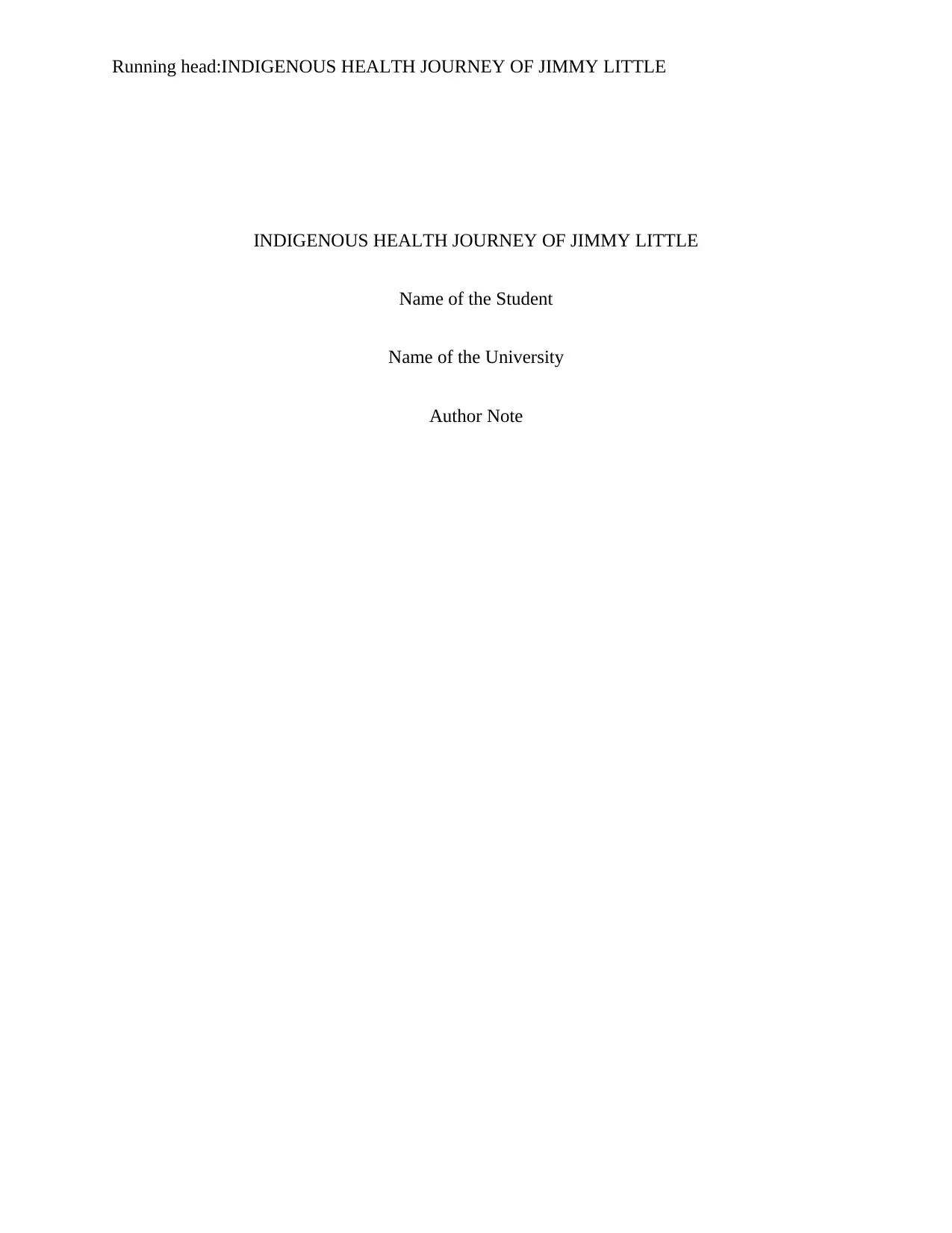
Running head:INDIGENOUS HEALTH JOURNEY OF JIMMY LITTLE
INDIGENOUS HEALTH JOURNEY OF JIMMY LITTLE
Name of the Student
Name of the University
Author Note
INDIGENOUS HEALTH JOURNEY OF JIMMY LITTLE
Name of the Student
Name of the University
Author Note
Paraphrase This Document
Need a fresh take? Get an instant paraphrase of this document with our AI Paraphraser
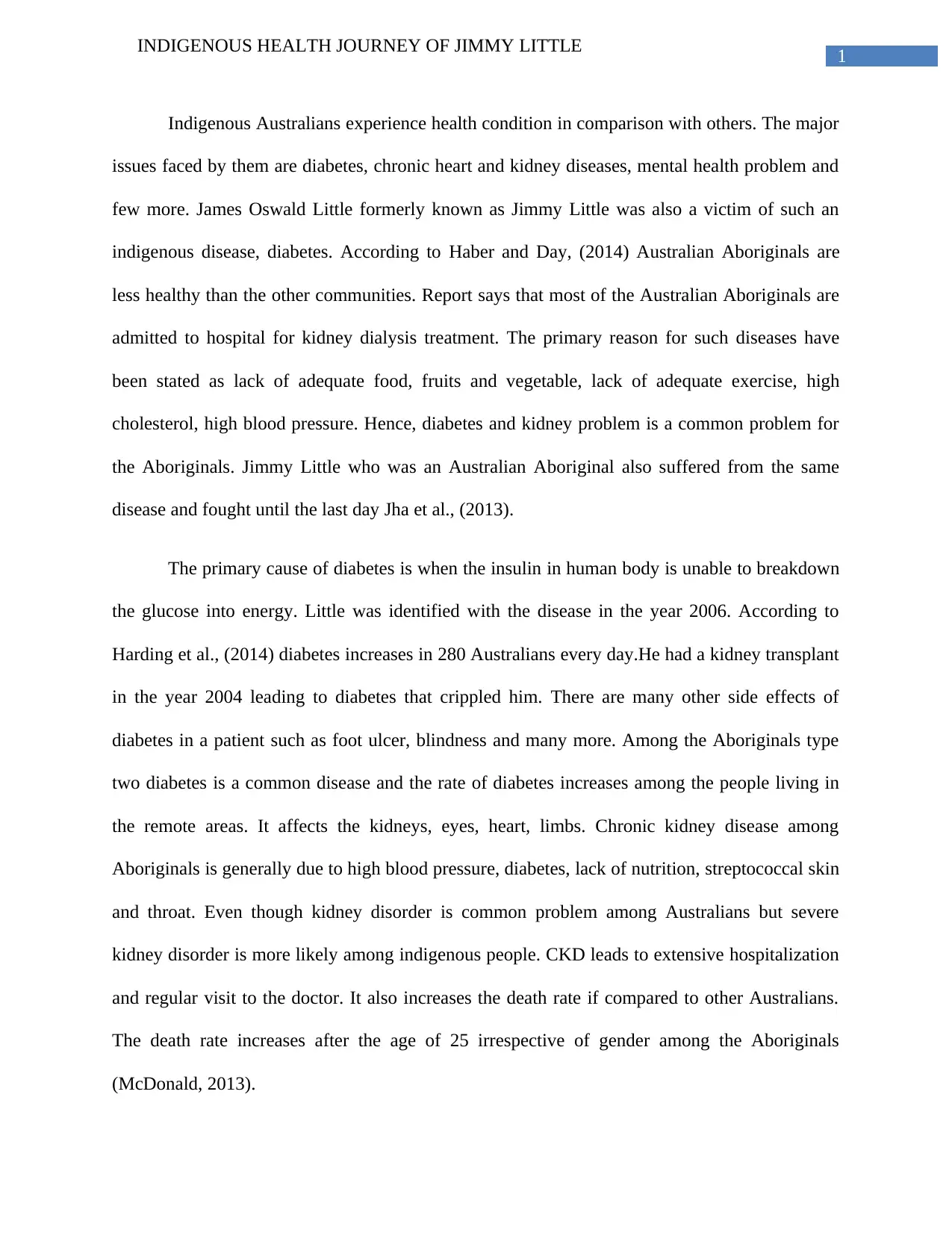
1
INDIGENOUS HEALTH JOURNEY OF JIMMY LITTLE
Indigenous Australians experience health condition in comparison with others. The major
issues faced by them are diabetes, chronic heart and kidney diseases, mental health problem and
few more. James Oswald Little formerly known as Jimmy Little was also a victim of such an
indigenous disease, diabetes. According to Haber and Day, (2014) Australian Aboriginals are
less healthy than the other communities. Report says that most of the Australian Aboriginals are
admitted to hospital for kidney dialysis treatment. The primary reason for such diseases have
been stated as lack of adequate food, fruits and vegetable, lack of adequate exercise, high
cholesterol, high blood pressure. Hence, diabetes and kidney problem is a common problem for
the Aboriginals. Jimmy Little who was an Australian Aboriginal also suffered from the same
disease and fought until the last day Jha et al., (2013).
The primary cause of diabetes is when the insulin in human body is unable to breakdown
the glucose into energy. Little was identified with the disease in the year 2006. According to
Harding et al., (2014) diabetes increases in 280 Australians every day.He had a kidney transplant
in the year 2004 leading to diabetes that crippled him. There are many other side effects of
diabetes in a patient such as foot ulcer, blindness and many more. Among the Aboriginals type
two diabetes is a common disease and the rate of diabetes increases among the people living in
the remote areas. It affects the kidneys, eyes, heart, limbs. Chronic kidney disease among
Aboriginals is generally due to high blood pressure, diabetes, lack of nutrition, streptococcal skin
and throat. Even though kidney disorder is common problem among Australians but severe
kidney disorder is more likely among indigenous people. CKD leads to extensive hospitalization
and regular visit to the doctor. It also increases the death rate if compared to other Australians.
The death rate increases after the age of 25 irrespective of gender among the Aboriginals
(McDonald, 2013).
INDIGENOUS HEALTH JOURNEY OF JIMMY LITTLE
Indigenous Australians experience health condition in comparison with others. The major
issues faced by them are diabetes, chronic heart and kidney diseases, mental health problem and
few more. James Oswald Little formerly known as Jimmy Little was also a victim of such an
indigenous disease, diabetes. According to Haber and Day, (2014) Australian Aboriginals are
less healthy than the other communities. Report says that most of the Australian Aboriginals are
admitted to hospital for kidney dialysis treatment. The primary reason for such diseases have
been stated as lack of adequate food, fruits and vegetable, lack of adequate exercise, high
cholesterol, high blood pressure. Hence, diabetes and kidney problem is a common problem for
the Aboriginals. Jimmy Little who was an Australian Aboriginal also suffered from the same
disease and fought until the last day Jha et al., (2013).
The primary cause of diabetes is when the insulin in human body is unable to breakdown
the glucose into energy. Little was identified with the disease in the year 2006. According to
Harding et al., (2014) diabetes increases in 280 Australians every day.He had a kidney transplant
in the year 2004 leading to diabetes that crippled him. There are many other side effects of
diabetes in a patient such as foot ulcer, blindness and many more. Among the Aboriginals type
two diabetes is a common disease and the rate of diabetes increases among the people living in
the remote areas. It affects the kidneys, eyes, heart, limbs. Chronic kidney disease among
Aboriginals is generally due to high blood pressure, diabetes, lack of nutrition, streptococcal skin
and throat. Even though kidney disorder is common problem among Australians but severe
kidney disorder is more likely among indigenous people. CKD leads to extensive hospitalization
and regular visit to the doctor. It also increases the death rate if compared to other Australians.
The death rate increases after the age of 25 irrespective of gender among the Aboriginals
(McDonald, 2013).
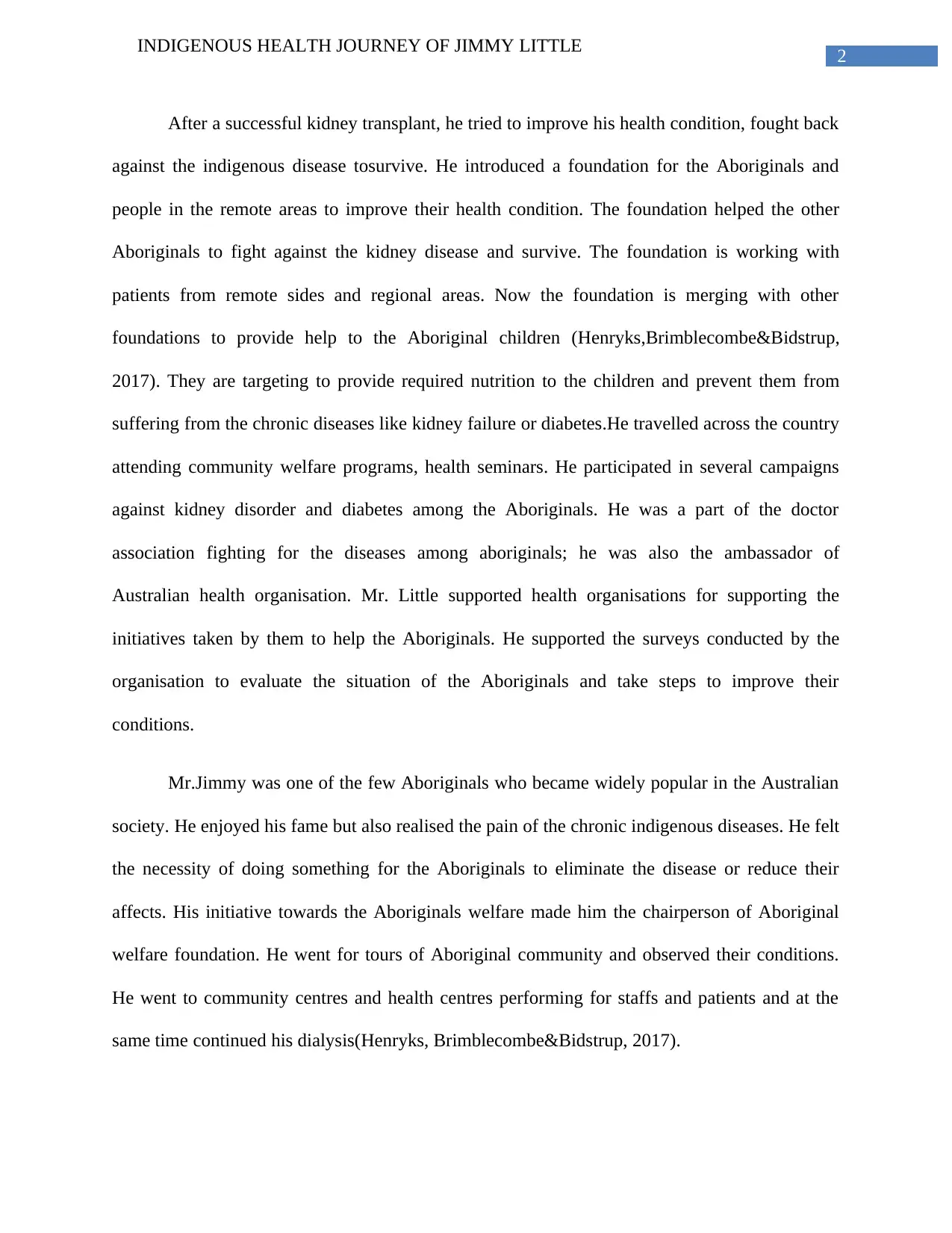
2
INDIGENOUS HEALTH JOURNEY OF JIMMY LITTLE
After a successful kidney transplant, he tried to improve his health condition, fought back
against the indigenous disease tosurvive. He introduced a foundation for the Aboriginals and
people in the remote areas to improve their health condition. The foundation helped the other
Aboriginals to fight against the kidney disease and survive. The foundation is working with
patients from remote sides and regional areas. Now the foundation is merging with other
foundations to provide help to the Aboriginal children (Henryks,Brimblecombe&Bidstrup,
2017). They are targeting to provide required nutrition to the children and prevent them from
suffering from the chronic diseases like kidney failure or diabetes.He travelled across the country
attending community welfare programs, health seminars. He participated in several campaigns
against kidney disorder and diabetes among the Aboriginals. He was a part of the doctor
association fighting for the diseases among aboriginals; he was also the ambassador of
Australian health organisation. Mr. Little supported health organisations for supporting the
initiatives taken by them to help the Aboriginals. He supported the surveys conducted by the
organisation to evaluate the situation of the Aboriginals and take steps to improve their
conditions.
Mr.Jimmy was one of the few Aboriginals who became widely popular in the Australian
society. He enjoyed his fame but also realised the pain of the chronic indigenous diseases. He felt
the necessity of doing something for the Aboriginals to eliminate the disease or reduce their
affects. His initiative towards the Aboriginals welfare made him the chairperson of Aboriginal
welfare foundation. He went for tours of Aboriginal community and observed their conditions.
He went to community centres and health centres performing for staffs and patients and at the
same time continued his dialysis(Henryks, Brimblecombe&Bidstrup, 2017).
INDIGENOUS HEALTH JOURNEY OF JIMMY LITTLE
After a successful kidney transplant, he tried to improve his health condition, fought back
against the indigenous disease tosurvive. He introduced a foundation for the Aboriginals and
people in the remote areas to improve their health condition. The foundation helped the other
Aboriginals to fight against the kidney disease and survive. The foundation is working with
patients from remote sides and regional areas. Now the foundation is merging with other
foundations to provide help to the Aboriginal children (Henryks,Brimblecombe&Bidstrup,
2017). They are targeting to provide required nutrition to the children and prevent them from
suffering from the chronic diseases like kidney failure or diabetes.He travelled across the country
attending community welfare programs, health seminars. He participated in several campaigns
against kidney disorder and diabetes among the Aboriginals. He was a part of the doctor
association fighting for the diseases among aboriginals; he was also the ambassador of
Australian health organisation. Mr. Little supported health organisations for supporting the
initiatives taken by them to help the Aboriginals. He supported the surveys conducted by the
organisation to evaluate the situation of the Aboriginals and take steps to improve their
conditions.
Mr.Jimmy was one of the few Aboriginals who became widely popular in the Australian
society. He enjoyed his fame but also realised the pain of the chronic indigenous diseases. He felt
the necessity of doing something for the Aboriginals to eliminate the disease or reduce their
affects. His initiative towards the Aboriginals welfare made him the chairperson of Aboriginal
welfare foundation. He went for tours of Aboriginal community and observed their conditions.
He went to community centres and health centres performing for staffs and patients and at the
same time continued his dialysis(Henryks, Brimblecombe&Bidstrup, 2017).
⊘ This is a preview!⊘
Do you want full access?
Subscribe today to unlock all pages.

Trusted by 1+ million students worldwide
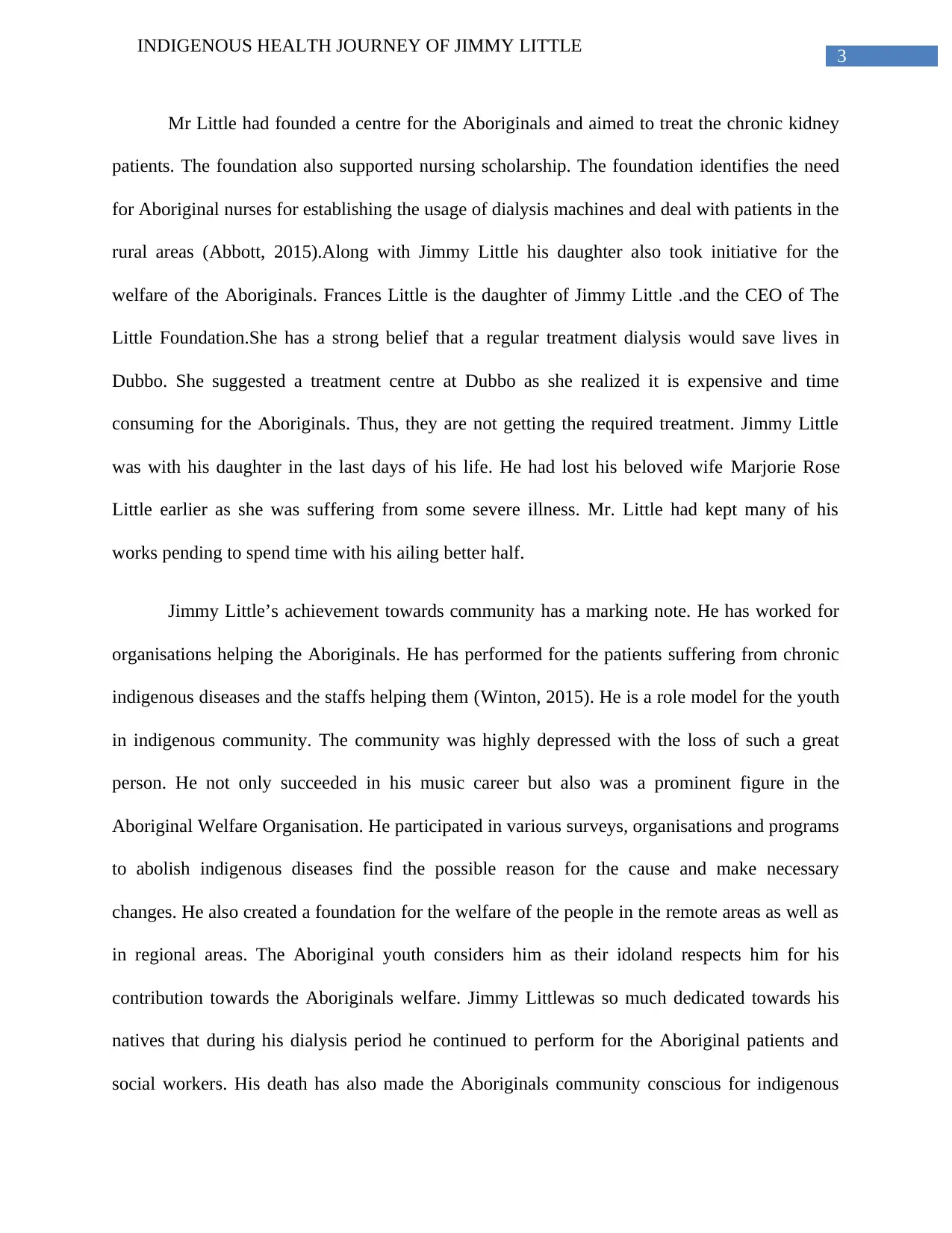
3
INDIGENOUS HEALTH JOURNEY OF JIMMY LITTLE
Mr Little had founded a centre for the Aboriginals and aimed to treat the chronic kidney
patients. The foundation also supported nursing scholarship. The foundation identifies the need
for Aboriginal nurses for establishing the usage of dialysis machines and deal with patients in the
rural areas (Abbott, 2015).Along with Jimmy Little his daughter also took initiative for the
welfare of the Aboriginals. Frances Little is the daughter of Jimmy Little .and the CEO of The
Little Foundation.She has a strong belief that a regular treatment dialysis would save lives in
Dubbo. She suggested a treatment centre at Dubbo as she realized it is expensive and time
consuming for the Aboriginals. Thus, they are not getting the required treatment. Jimmy Little
was with his daughter in the last days of his life. He had lost his beloved wife Marjorie Rose
Little earlier as she was suffering from some severe illness. Mr. Little had kept many of his
works pending to spend time with his ailing better half.
Jimmy Little’s achievement towards community has a marking note. He has worked for
organisations helping the Aboriginals. He has performed for the patients suffering from chronic
indigenous diseases and the staffs helping them (Winton, 2015). He is a role model for the youth
in indigenous community. The community was highly depressed with the loss of such a great
person. He not only succeeded in his music career but also was a prominent figure in the
Aboriginal Welfare Organisation. He participated in various surveys, organisations and programs
to abolish indigenous diseases find the possible reason for the cause and make necessary
changes. He also created a foundation for the welfare of the people in the remote areas as well as
in regional areas. The Aboriginal youth considers him as their idoland respects him for his
contribution towards the Aboriginals welfare. Jimmy Littlewas so much dedicated towards his
natives that during his dialysis period he continued to perform for the Aboriginal patients and
social workers. His death has also made the Aboriginals community conscious for indigenous
INDIGENOUS HEALTH JOURNEY OF JIMMY LITTLE
Mr Little had founded a centre for the Aboriginals and aimed to treat the chronic kidney
patients. The foundation also supported nursing scholarship. The foundation identifies the need
for Aboriginal nurses for establishing the usage of dialysis machines and deal with patients in the
rural areas (Abbott, 2015).Along with Jimmy Little his daughter also took initiative for the
welfare of the Aboriginals. Frances Little is the daughter of Jimmy Little .and the CEO of The
Little Foundation.She has a strong belief that a regular treatment dialysis would save lives in
Dubbo. She suggested a treatment centre at Dubbo as she realized it is expensive and time
consuming for the Aboriginals. Thus, they are not getting the required treatment. Jimmy Little
was with his daughter in the last days of his life. He had lost his beloved wife Marjorie Rose
Little earlier as she was suffering from some severe illness. Mr. Little had kept many of his
works pending to spend time with his ailing better half.
Jimmy Little’s achievement towards community has a marking note. He has worked for
organisations helping the Aboriginals. He has performed for the patients suffering from chronic
indigenous diseases and the staffs helping them (Winton, 2015). He is a role model for the youth
in indigenous community. The community was highly depressed with the loss of such a great
person. He not only succeeded in his music career but also was a prominent figure in the
Aboriginal Welfare Organisation. He participated in various surveys, organisations and programs
to abolish indigenous diseases find the possible reason for the cause and make necessary
changes. He also created a foundation for the welfare of the people in the remote areas as well as
in regional areas. The Aboriginal youth considers him as their idoland respects him for his
contribution towards the Aboriginals welfare. Jimmy Littlewas so much dedicated towards his
natives that during his dialysis period he continued to perform for the Aboriginal patients and
social workers. His death has also made the Aboriginals community conscious for indigenous
Paraphrase This Document
Need a fresh take? Get an instant paraphrase of this document with our AI Paraphraser
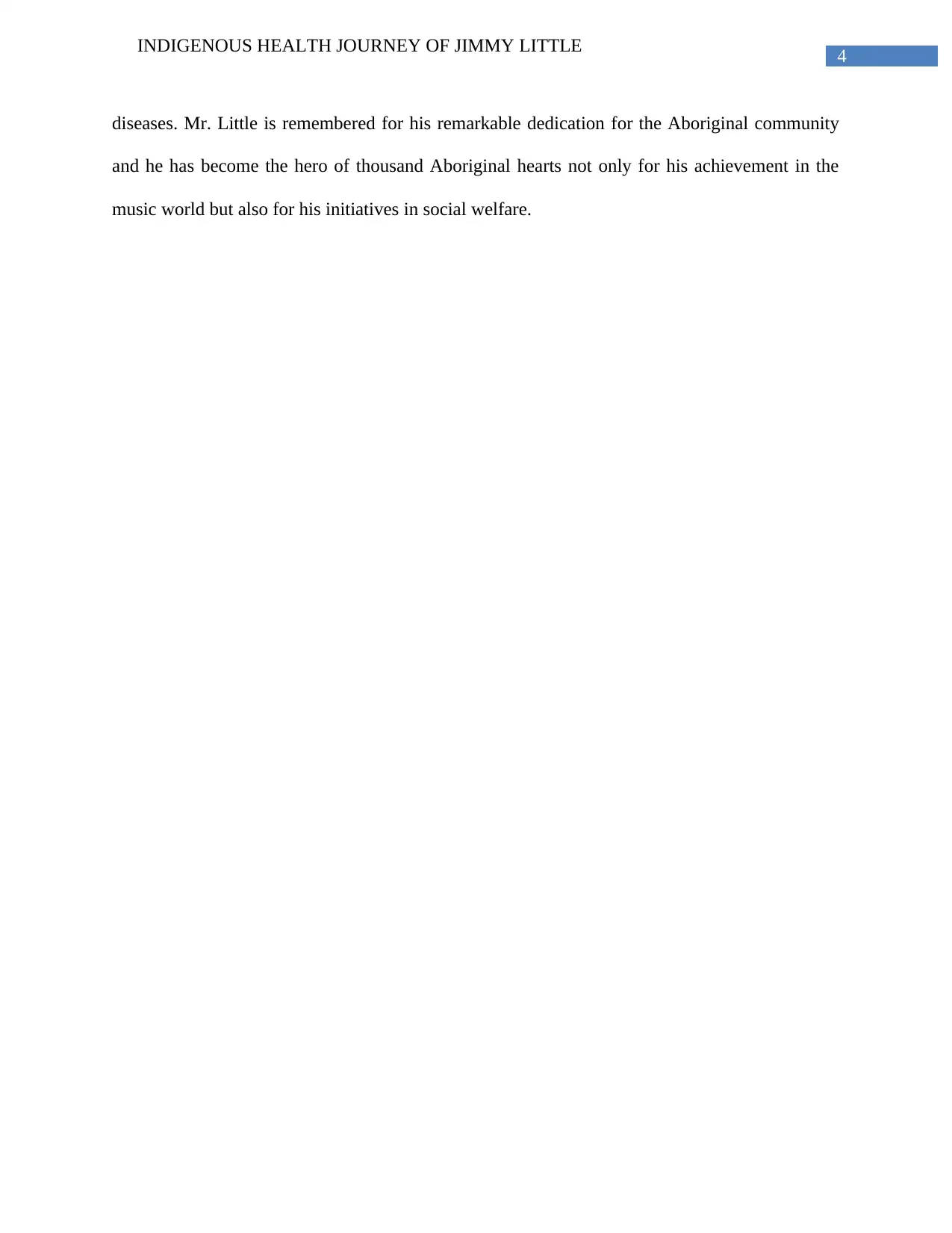
4
INDIGENOUS HEALTH JOURNEY OF JIMMY LITTLE
diseases. Mr. Little is remembered for his remarkable dedication for the Aboriginal community
and he has become the hero of thousand Aboriginal hearts not only for his achievement in the
music world but also for his initiatives in social welfare.
INDIGENOUS HEALTH JOURNEY OF JIMMY LITTLE
diseases. Mr. Little is remembered for his remarkable dedication for the Aboriginal community
and he has become the hero of thousand Aboriginal hearts not only for his achievement in the
music world but also for his initiatives in social welfare.
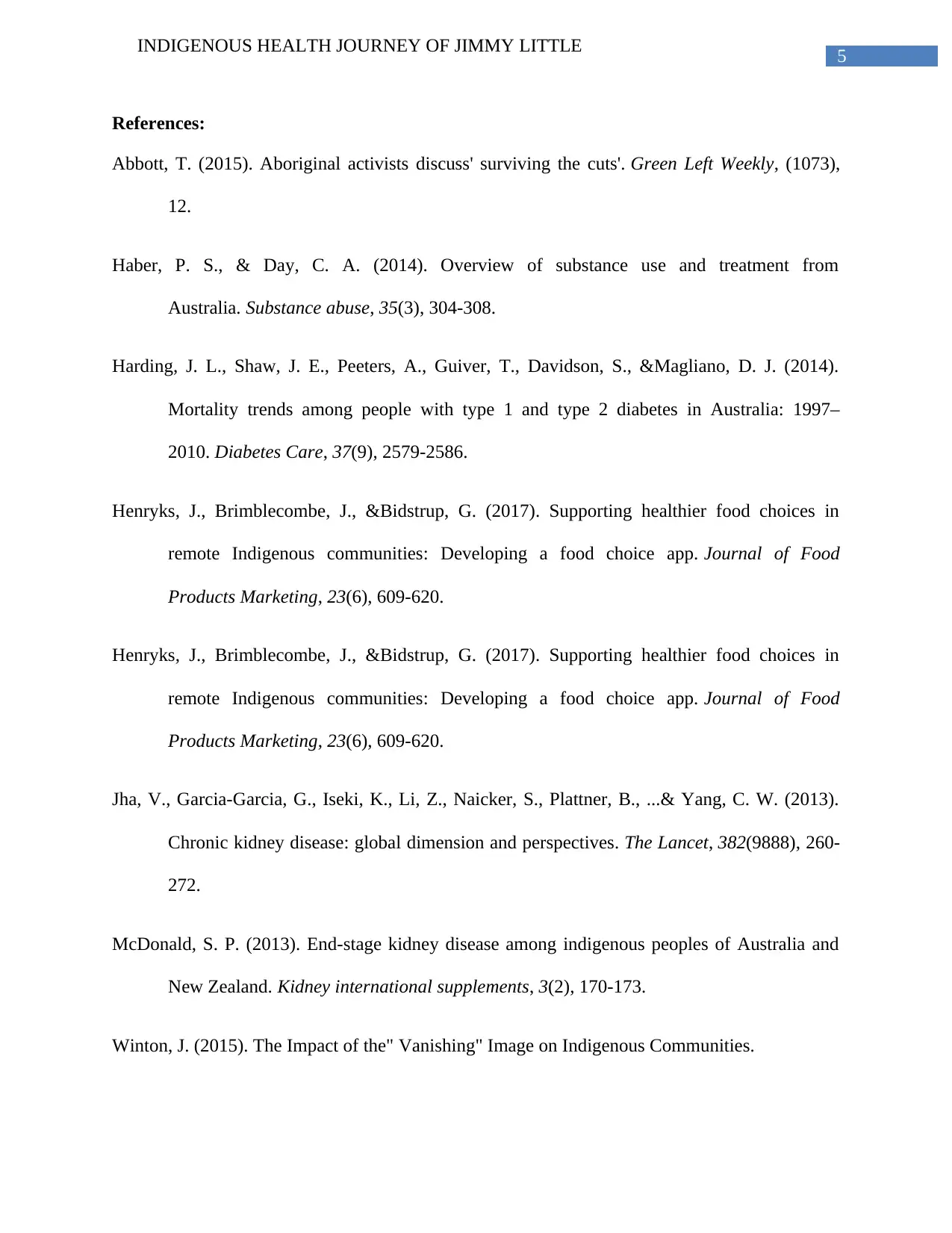
5
INDIGENOUS HEALTH JOURNEY OF JIMMY LITTLE
References:
Abbott, T. (2015). Aboriginal activists discuss' surviving the cuts'. Green Left Weekly, (1073),
12.
Haber, P. S., & Day, C. A. (2014). Overview of substance use and treatment from
Australia. Substance abuse, 35(3), 304-308.
Harding, J. L., Shaw, J. E., Peeters, A., Guiver, T., Davidson, S., &Magliano, D. J. (2014).
Mortality trends among people with type 1 and type 2 diabetes in Australia: 1997–
2010. Diabetes Care, 37(9), 2579-2586.
Henryks, J., Brimblecombe, J., &Bidstrup, G. (2017). Supporting healthier food choices in
remote Indigenous communities: Developing a food choice app. Journal of Food
Products Marketing, 23(6), 609-620.
Henryks, J., Brimblecombe, J., &Bidstrup, G. (2017). Supporting healthier food choices in
remote Indigenous communities: Developing a food choice app. Journal of Food
Products Marketing, 23(6), 609-620.
Jha, V., Garcia-Garcia, G., Iseki, K., Li, Z., Naicker, S., Plattner, B., ...& Yang, C. W. (2013).
Chronic kidney disease: global dimension and perspectives. The Lancet, 382(9888), 260-
272.
McDonald, S. P. (2013). End-stage kidney disease among indigenous peoples of Australia and
New Zealand. Kidney international supplements, 3(2), 170-173.
Winton, J. (2015). The Impact of the" Vanishing" Image on Indigenous Communities.
INDIGENOUS HEALTH JOURNEY OF JIMMY LITTLE
References:
Abbott, T. (2015). Aboriginal activists discuss' surviving the cuts'. Green Left Weekly, (1073),
12.
Haber, P. S., & Day, C. A. (2014). Overview of substance use and treatment from
Australia. Substance abuse, 35(3), 304-308.
Harding, J. L., Shaw, J. E., Peeters, A., Guiver, T., Davidson, S., &Magliano, D. J. (2014).
Mortality trends among people with type 1 and type 2 diabetes in Australia: 1997–
2010. Diabetes Care, 37(9), 2579-2586.
Henryks, J., Brimblecombe, J., &Bidstrup, G. (2017). Supporting healthier food choices in
remote Indigenous communities: Developing a food choice app. Journal of Food
Products Marketing, 23(6), 609-620.
Henryks, J., Brimblecombe, J., &Bidstrup, G. (2017). Supporting healthier food choices in
remote Indigenous communities: Developing a food choice app. Journal of Food
Products Marketing, 23(6), 609-620.
Jha, V., Garcia-Garcia, G., Iseki, K., Li, Z., Naicker, S., Plattner, B., ...& Yang, C. W. (2013).
Chronic kidney disease: global dimension and perspectives. The Lancet, 382(9888), 260-
272.
McDonald, S. P. (2013). End-stage kidney disease among indigenous peoples of Australia and
New Zealand. Kidney international supplements, 3(2), 170-173.
Winton, J. (2015). The Impact of the" Vanishing" Image on Indigenous Communities.
⊘ This is a preview!⊘
Do you want full access?
Subscribe today to unlock all pages.

Trusted by 1+ million students worldwide
1 out of 6
Related Documents
Your All-in-One AI-Powered Toolkit for Academic Success.
+13062052269
info@desklib.com
Available 24*7 on WhatsApp / Email
![[object Object]](/_next/static/media/star-bottom.7253800d.svg)
Unlock your academic potential
Copyright © 2020–2025 A2Z Services. All Rights Reserved. Developed and managed by ZUCOL.





